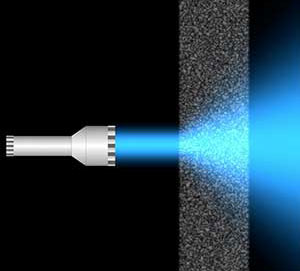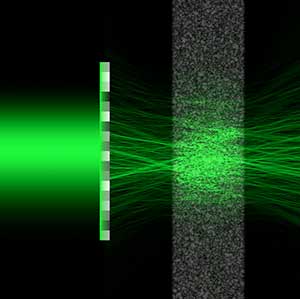| Mar 04, 2019 | |
New shapes of laser beam 'sneak' through opaque media(Nanowerk News) Researchers have found a way to pre-treat a laser beam so that it enters opaque surfaces without dispersing — like a headlight that’s able to cut through heavy fog at full strength. |
|
| The discovery from scientists at Yale University and the Missouri University of Science & Technology has potential applications for deep-tissue imaging and optogenetics, in which light is used to probe and manipulate cells in living tissue. | |
| A study announcing the technique appears in the journal Nature Photonics ("Transverse localization of transmission eigenchannels"). | |
 |
|
| When a flashlight beam shines onto a strongly scattering medium such as white paint, the light diffuses in both longitudinal and lateral directions. Consequently, the transmitted beam becomes wider and the intensity is lower. (Image: Yale University) | |
| “Typically, an optical beam propagating through a diffusive medium such as fog will spread laterally, but we have discovered that a special preparation of the laser beam can transmit all incoming light without lateral spread,” said principal investigator Hui Cao, the John C. Malone Professor of Applied Physics and of Physics at Yale. | |
| The researchers used a spatial light modulator (SLM) and a charge-coupled device (CCD) camera to analyze an opaque material that is made of a layer of white paint. The SLM tailored the laser beam incident on the front surface of the material, and the CCD camera records intensity profiles behind it. With this information, the laser finds a “route” through the white paint. | |
| Spatial wavefront laser propagating through a strongly scattering medium without latteral diffusion. By shaping its spatial wavefront, a laser beam can propagate through a strongly scattering medium without lateral diffusion. | |
| Moreover, the backscattering of light is suppressed. The enhancement of light transmittance and the suppression of lateral beam spreading keep the optical energy density high throughout the scattering medium. | |
| The result is a beam that is more concentrated, with more light per volume inside and behind the opaque material. In addition to a layer of white paint, the materials in which the laser would be effective include biological tissue, fog, paper, and milk. | |
 |
|
| By shaping its spatial wavefront, a laser beam can propagate through a strongly scattering medium without lateral diffusion. Moreover, the backscattering of light is suppressed. The enhancement of light transmittance and the suppression of lateral beam spreading keep the optical energy density high throughout the scattering medium. (Image: Yale University) | |
| “Our method works for any opaque medium that does not absorb light,” Cao said. | |
| The first author of the study is Yale postdoctoral research associate Hasan Yilmaz. Additional authors are Yale postdoctoral researcher Chia Wei Hsu and Missouri University of Science and Technology associate professor Alexey Yamilov. | |
| “Enhancing optical energy in opaque scattering media is extremely important in optogenetics and deep-tissue imaging,” Yilmaz said. “Currently, penetration depth to probe and stimulate or image neurons inside the brain tissue is limited due to multiple-scattering.” |
| Source: Yale University | |
|
Subscribe to a free copy of one of our daily Nanowerk Newsletter Email Digests with a compilation of all of the day's news. |
